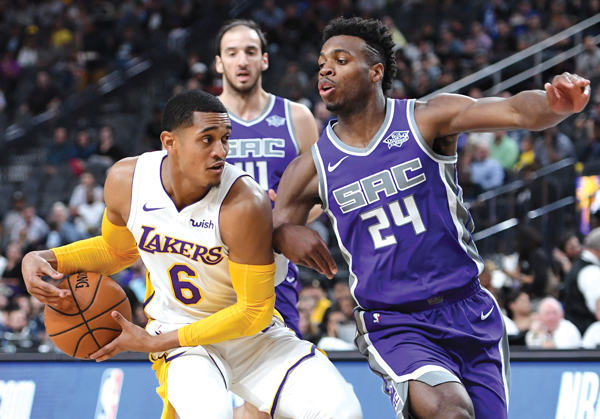 |
The Lakers signed e-commerce site Wish while the Kings went with Blue Diamond almonds.
Photo by: GETTY IMAGES |
The NBA breaks new ground this season by putting advertising on game jerseys, with more than half of the league’s 30 teams signing deals for an average of $9.3 million annually, according to one industry expert involved in the program.
The average jersey patch deal value compiled by Wasserman, which did deal evaluations for 15 NBA teams, including the Golden State Warriors’ record $20 million yearly deal with Japanese tech company Rakuten, is in line with the $9 million average initially forecast by Wasserman.
“It has been trending slightly up from projections,” said Elizabeth Lindsey, who heads the marketing division at Wasserman. “An asset of this magnitude is one that you don’t package alone. It is just below naming rights as far as team inventory, so you don’t sell it on its own. You can see that every team treated it differently as far as what was packaged.”
But selling the high-priced inventory has proved no easy task given it had never been done in any of the four top U.S. stick and ball leagues. That unfamiliarity, along with the deeply integrated and high valuations of the deals, is why the league gave teams an 18-month runway to sell the patches. Big-market teams without jersey patch deals last week included the Chicago Bulls, Los Angeles Clippers and Houston Rockets, as those teams continued to look for the right partner — and right price.
“It’s a different kind of sale; the narrative is different, the approach has to be different,” said Brett Yormark, chief executive officer of Brooklyn Sports & Entertainment, which owns the Nets. The Nets were the fourth team to sell a jersey patch sponsorship, landing software company Infor in a deal worth $8 million a year.
“This isn’t just a signage, branding or exposure story,” Yormark said. “It has to be a bigger play, and obviously the expense is much bigger. You can’t sell the patch like everything else. It requires more thoughtfulness; there’s fewer potential companies. It’s a bigger story and a deeper connection between the team and the brand.”
The Nets’ deal with Infor, for example, calls for the company to develop analytics to measure player performance, business operations, and fan experience.
With at least 17 teams now having jersey patch deals, and a handful more expected soon, the league expects to have about two-thirds of NBA teams with deals in place this season.
While the brands doing jersey deals range from tech companies such as Fitbit with the Minnesota Timberwolves to old-line companies such as Goodyear, which bought the Cleveland Cavaliers’ patch, most of the jersey patch deals are with companies that had never been NBA sponsors. The Utah Jazz is the only team with a cause-related patch deal; analytics company Qualtrics will put its 5 For The Fight cancer charity logo on the team’s jersey. But the company will also activate around the deal by developing fan experience data for the team after also signing on as the team’s exclusive fan experience insights and analytics partner.
“The mix of the companies is unique and shows the breadth of the appeal,” said Amy Brooks, executive vice president of the NBA’s team marketing and business operations division. “The majority are locally based brands with global reaches.”
Brooks said teams without jersey patch deals will be allowed to sign deals during the season.
“When we created this at the league, we’d envisioned a number of new brands coming into the league, rather than just an additional spend by existing sponsors, and largely that is what we have seen,” said Emilio Collins, chief business officer at Excel Sports Management and a former senior NBA sponsorship executive who helped create the jersey patch program. “It has slightly exceeded the pace I expected. I thought it was going to be about half the teams going into the season and obviously it is a bit more than that.”
Adding to the difficulty in selling the patch is the packaging of other team assets into the jersey sponsorship. The Warriors’ jersey deal with Rakuten, for example, also includes naming rights to the team’s practice facility for the next two seasons before the Warriors move from Oakland to San Francisco. The Los Angeles Lakers signed a deal with e-commerce company Wish and included a patch on its G League team jersey as part of its overall deal worth between $12 million and $14 million annually.
The league computes the actual value of the jersey patch deals, separate from any other team assets that might be included.
“We have a rigorous process to standardize the valuation of the patch,” Brooks said, declining to disclose specifics.
Half of the revenue from jersey patch deals will go to the players. Of the remaining 50 percent, 25 percent will go to the team selling the patch, with the remaining 25 percent to be shared among the remaining 29 teams.
One of the most complicated deals is in Charlotte, where the Hornets are searching for the right jersey patch partner that will align with the Jordan Brand logo that will also be on the team’s jersey as part of the league’s new apparel deal with Nike.
“We are in a unique position in being the only Jordan Brand in the NBA, so we are looking for synergy,” said Pete Guelli, executive vice president and chief sales and marketing officer for the Hornets. He would not put a time frame on any jersey patch deal with the team.
“We have had multiple offers, but none we could pull the trigger on,” he said. “But the market is being established and reset every day. It is only increasing.”
NBA ad spending
A total of 919 brands combined to create 3,160 unique commercials during NBA programming last season, for a total outlay of $1.1 billion across 54,635 commercials, according to SportsBusiness Journal’s analysis of iSpot.tv data.




